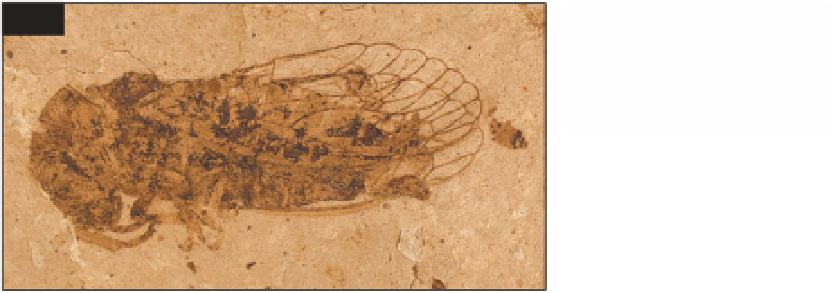Geoscience Reference
In-Depth Information
become hardened, protective cases for
the folded hindwings. They rarely fly
but scavenge on dead plants and animals,
and also eat live plant material. The
ground-dwelling, detritus-feeding roaches
(Blattaria) occur only rarely at Florissant,
but their relatives, the termites (Isoptera),
are commoner. Termites are social insects
whose body fossils occur in rocks of early
Cretaceous age (Grimaldi and Engel,
2005) but whose characteristic colonies
have been found in rocks as old as the
Triassic Chinle Group (Chapter 8; Hasiotis
and Dubiel, 1995). Termite society is
formed of castes consisting of reproductive
individuals, workers, and soldiers. An
important attribute of termites is their
ability to digest cellulose, the molecule
which makes plant cell walls and wood,
with the help of symbiotic microbes in
their gut. They spend most of their time
underground but each year members of
the reproductive caste develop wings,
swarm, and establish new colonies where
they mate and shed their wings. It is during
this swarming period that they are most
likely to become trapped in the lake and so
most fossil termites are the winged form.
Hemiptera is the largest group of
non-holometabolous insects alive today.
That is, they use the primitive method of
growth in which the nymph hatching
from the egg resembles a small adult,
rather than a caterpillar or grub (larva)
that metamorphoses into a pupa before
emerging as an adult, as in the more
advanced,
Hemiptera have piercing-and-sucking
mouthparts, which they use to suck
juices from plants (sap) or animals (blood).
The Sternorrhyncha include important sap-
sucking pests such as aphids, whitefly,
and scale-insects. They are represented
at Florissant by many species. Today,
many aphids live in association with
ants, also common at Florissant. It has
been suggested that the two groups
coevolved from the early Cenozoic
onwards, although the radiation of the
aphids was almost certainly triggered
by the rise of the angiosperms (Grimaldi
and Engel, 2005). Auchenorrhyncha
include the cicadas (
234
) and plant
hoppers (
235
). Like the Sternorrhyncha,
nearly all feed on plant sap, and mostly on
angiosperms. The earliest (Permian-
Jurassic) cicada-like paleontinids must have
fed on gymnosperms, as must the earliest
true cicadas of early Jurasic age. One extinct
genus of plant hopper,
Florissantia
, shares
its name with that of a flower; though rare,
this is allowed because botany and zoology
have different nomenclatural codes.
The Heteroptera, or true bugs, are
recognized by the proximal part of
their forewings being stiffened while the
distal part is membranous like the
hindwings. Many, like the shield bugs,
are terrestrial plant-suckers, but others
are predatory. The assassin bugs
are formidable predators on insects
for which they lie in wait on flowers.
Nearly all of the aquatic bugs are
predators, for example the backswimmers
holometabolous
insects.
234
234 Cicada Platypedia
primigeniaHemiptera:
Sternorrhyncha: Cicadidae
NHM. Body length 23 mm
0.9 in.




Search WWH ::

Custom Search